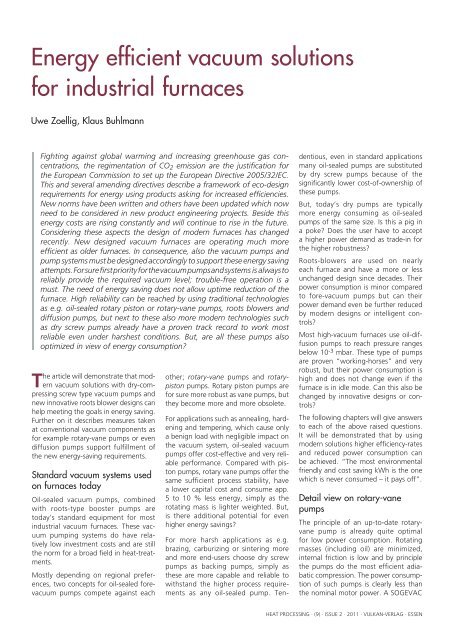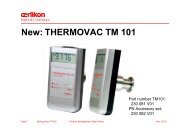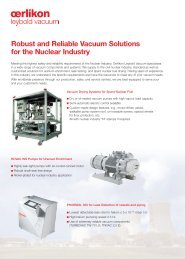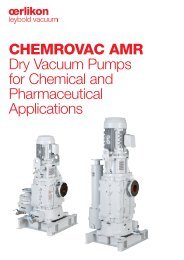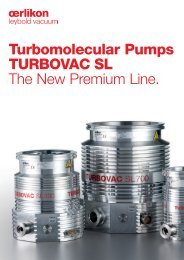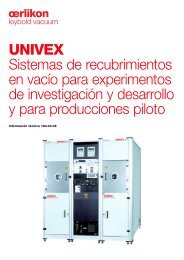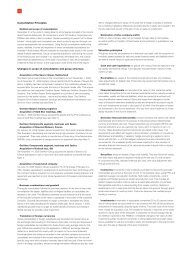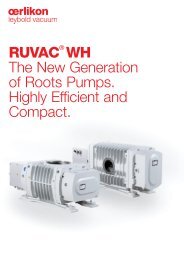Energy efficient vacuum solutions for industrial furnaces
Energy efficient vacuum solutions for industrial furnaces
Energy efficient vacuum solutions for industrial furnaces
You also want an ePaper? Increase the reach of your titles
YUMPU automatically turns print PDFs into web optimized ePapers that Google loves.
<strong>Energy</strong> <strong>efficient</strong> <strong>vacuum</strong> <strong>solutions</strong><br />
<strong>for</strong> <strong>industrial</strong> <strong>furnaces</strong><br />
Uwe Zoellig, Klaus Buhlmann<br />
Fighting against global warming and increasing greenhouse gas concentrations,<br />
the regimentation of CO2 emission are the justification <strong>for</strong><br />
the European Commission to set up the European Directive 2005/32/EC.<br />
This and several amending directives describe a framework of eco-design<br />
requirements <strong>for</strong> energy using products asking <strong>for</strong> increased efficiencies.<br />
New norms have been written and others have been updated which now<br />
need to be considered in new product engineering projects. Beside this<br />
energy costs are rising constantly and will continue to rise in the future.<br />
Considering these aspects the design of modern <strong>furnaces</strong> has changed<br />
recently. New designed <strong>vacuum</strong> <strong>furnaces</strong> are operating much more<br />
<strong>efficient</strong> as older <strong>furnaces</strong>. In consequence, also the <strong>vacuum</strong> pumps and<br />
pump systems must be designed accordingly to support these energy saving<br />
attempts. For sure first priority <strong>for</strong> the <strong>vacuum</strong> pumps and systems is always to<br />
reliably provide the required <strong>vacuum</strong> level; trouble-free operation is a<br />
must. The need of energy saving does not allow uptime reduction of the<br />
furnace. High reliability can be reached by using traditional technologies<br />
as e.g. oil-sealed rotary piston or rotary-vane pumps, roots blowers and<br />
diffusion pumps, but next to these also more modern technologies such<br />
as dry screw pumps already have a proven track record to work most<br />
reliable even under harshest conditions. But, are all these pumps also<br />
optimized in view of energy consumption?<br />
The article will demonstrate that modern<br />
<strong>vacuum</strong> <strong>solutions</strong> with dry-compressing<br />
screw type <strong>vacuum</strong> pumps and<br />
new innovative roots blower designs can<br />
help meeting the goals in energy saving.<br />
Further on it describes measures taken<br />
at conventional <strong>vacuum</strong> components as<br />
<strong>for</strong> example rotary-vane pumps or even<br />
diffusion pumps support fulfillment of<br />
the new energy-saving requirements.<br />
Standard <strong>vacuum</strong> systems used<br />
on <strong>furnaces</strong> today<br />
Oil-sealed <strong>vacuum</strong> pumps, combined<br />
with roots-type booster pumps are<br />
today’s standard equipment <strong>for</strong> most<br />
<strong>industrial</strong> <strong>vacuum</strong> <strong>furnaces</strong>. These <strong>vacuum</strong><br />
pumping systems do have relatively<br />
low investment costs and are still<br />
the norm <strong>for</strong> a broad field in heat-treatments.<br />
Mostly depending on regional preferences,<br />
two concepts <strong>for</strong> oil-sealed <strong>for</strong>e<strong>vacuum</strong><br />
pumps compete against each<br />
other; rotary-vane pumps and rotarypiston<br />
pumps. Rotary piston pumps are<br />
<strong>for</strong> sure more robust as vane pumps, but<br />
they become more and more obsolete.<br />
For applications such as annealing, hardening<br />
and tempering, which cause only<br />
a benign load with negligible impact on<br />
the <strong>vacuum</strong> system, oil-sealed <strong>vacuum</strong><br />
pumps offer cost-effective and very reliable<br />
per<strong>for</strong>mance. Compared with piston<br />
pumps, rotary vane pumps offer the<br />
same sufficient process stability, have<br />
a lower capital cost and consume app.<br />
5 to 10 % less energy, simply as the<br />
rotating mass is lighter weighted. But,<br />
is there additional potential <strong>for</strong> even<br />
higher energy savings?<br />
For more harsh applications as e.g.<br />
brazing, carburizing or sintering more<br />
and more end-users choose dry screw<br />
pumps as backing pumps, simply as<br />
these are more capable and reliable to<br />
withstand the higher process requirements<br />
as any oil-sealed pump. Ten-<br />
dentious, even in standard applications<br />
many oil-sealed pumps are substituted<br />
by dry screw pumps because of the<br />
significantly lower cost-of-ownership of<br />
these pumps.<br />
But, today’s dry pumps are typically<br />
more energy consuming as oil-sealed<br />
pumps of the same size. Is this a pig in<br />
a poke? Does the user have to accept<br />
a higher power demand as trade-in <strong>for</strong><br />
the higher robustness?<br />
Roots-blowers are used on nearly<br />
each furnace and have a more or less<br />
unchanged design since decades. Their<br />
power consumption is minor compared<br />
to <strong>for</strong>e-<strong>vacuum</strong> pumps but can their<br />
power demand even be further reduced<br />
by modern designs or intelligent controls?<br />
Most high-<strong>vacuum</strong> <strong>furnaces</strong> use oil-diffusion<br />
pumps to reach pressure ranges<br />
below 10-3 mbar. These type of pumps<br />
are proven “working-horses” and very<br />
robust, but their power consumption is<br />
high and does not change even if the<br />
furnace is in idle mode. Can this also be<br />
changed by innovative designs or controls?<br />
The following chapters will give answers<br />
to each of the above raised questions.<br />
It will be demonstrated that by using<br />
modern <strong>solutions</strong> higher efficiency-rates<br />
and reduced power consumption can<br />
be achieved. “The most environmental<br />
friendly and cost saving kWh is the one<br />
which is never consumed – it pays off”.<br />
Detail view on rotary-vane<br />
pumps<br />
The principle of an up-to-date rotaryvane<br />
pump is already quite optimal<br />
<strong>for</strong> low power consumption. Rotating<br />
masses (including oil) are minimized,<br />
internal friction is low and by principle<br />
the pumps do the most <strong>efficient</strong> adiabatic<br />
compression. The power consumption<br />
of such pumps is clearly less than<br />
the nominal motor power. A SOGEVAC<br />
HEAT PROCESSING · (9) · ISSUE 2 · 2011 · VULKAN-VERLAG · ESSEN
SV630B <strong>for</strong> example (Fig. 1) is equipped<br />
with a 15 kW flange motor. The effective<br />
power consumption of this pump<br />
at a typical operation pressure <strong>for</strong> a<br />
furnace below 1 mbar is approximately<br />
7.4 kW.<br />
New pump deliveries will include IE2<br />
motors, which meet latest standards.<br />
Motors declared IE2 have a higher<br />
efficiency factor, all kind of losses, such<br />
as iron- and copper-losses, are minimized<br />
to achieve a higher efficiency.<br />
Realistically additional energy saving can<br />
only be reached by operating the pumps<br />
motor with a matched variable speed<br />
drive (converter). Thus an optimum in<br />
per<strong>for</strong>mance can be achieved. Ramp up<br />
function and torque optimization are<br />
two features among other provided by<br />
modern variable speed drives. Next to<br />
this frequency drives offers extended<br />
possibilities <strong>for</strong> process control, e.g.<br />
a suction speed reduction during the<br />
boost phase of a carburizing process to<br />
reduce HC-gas consumption.<br />
Detail view on screw-type dry<br />
<strong>vacuum</strong> pumps<br />
Today’s standard dry pumps are screw<br />
pumps with variable pitch rotor design.<br />
Fig. 2: Layout of the hermetically sealed DRYVAC screw pumps<br />
featuring 2 rotors with progressive pitch profile and build-in<br />
frequency-converter driven high-efficiency motor<br />
HEAT PROCESSING · (9) · ISSUE 2 · 2011 · VULKAN-VERLAG · ESSEN<br />
Fig. 1: <strong>Energy</strong> <strong>efficient</strong> standard pump <strong>for</strong><br />
benign applications: SOGEVAC SV300B<br />
Continues compression along the rotor<br />
length minimizes the energy demand.<br />
Older technologies with constant screw<br />
pitch or even dry pumps based on multiple<br />
stages of roots- or claw type rotors,<br />
have a significantly higher power consumption<br />
due to design and pumping<br />
principle.<br />
But even the plurality of today’s screwpumps<br />
with variable pitch, differ a lot<br />
from each other. Most pumps of the<br />
600 m³/h class demand app. 10 kW<br />
power at typical furnace operation pressures<br />
below 1 mbar, which is a clearly<br />
higher value as those of a comparable<br />
rotary-vane pump.<br />
During the development of DRYVAC<br />
(Fig. 2), reduction of energy consumption<br />
was a mayor focus. Optimizing the<br />
mechanical rotor design, the electrical<br />
motor concept and by selection of a<br />
perfectly matched build-in frequency<br />
converter the achieved result is overwhelming.<br />
The DRYVAC 650S (Fig. 3) does only<br />
consume 6.9 kW at 1 mbar, it is even<br />
more energy <strong>efficient</strong> than a rotary-vane<br />
pump and by this becomes the new<br />
bench mark <strong>for</strong> power consumption in<br />
the market.<br />
The build-in frequency converter also<br />
offers potential <strong>for</strong> additional savings<br />
and more process control. Many process<br />
steps do not require “full-power” suction<br />
speed, especially during operation<br />
at rougher pressures (e.g. during carburizing).<br />
Soft start and ramping functionality<br />
can be realized with the variable<br />
frequency drive. Chamber pressure can<br />
be controlled by varying the rotational<br />
speed. The customer can even realize<br />
a process specific “standby condition”<br />
considering certain valve positions to<br />
save <strong>for</strong> example the volume of supplied<br />
Nitrogen.<br />
Next to these environmental issues, <strong>for</strong><br />
sure the modern design of the DRYVAC<br />
does eliminate sensitive components as<br />
shaft-seals or couplings which clearly<br />
increase robustness and reliability of the<br />
pump.<br />
Detail view on roots-type<br />
<strong>vacuum</strong> blowers<br />
Most roots pumps used today are standard<br />
designs with flanged motors and<br />
lip-type shaft sealing. For most applications<br />
this design is sufficient, but it<br />
includes some weaknesses:<br />
• Shaft-sealing, couplings and motorbearings<br />
wear down over time<br />
• Shaft-seals do not allow an operation<br />
at significantly increased rotary<br />
speed.<br />
• The motor is mostly a standard motor<br />
not really matched to the pump <strong>for</strong><br />
optimal usage.<br />
The first two points could be addressed<br />
by usage of the well known “cannedmotor”<br />
pumps, such as the RUVAC<br />
WS2001 – since years available on the<br />
market. However, when looking at<br />
energy-efficiency this is a step back-<br />
Fig. 3: Picture: DRYVAC Enduro 650S, the new<br />
most energy <strong>efficient</strong> standard <strong>for</strong> demanding heattreatment<br />
applications
Fig. 4: Motor concepts of a standard roots-pump (left) and a RUVAC WH roots-type booster<br />
pump (right)<br />
wards, as the canned motors typically<br />
operate by far less <strong>efficient</strong> than standard<br />
flange motors.<br />
More promising are the most modern<br />
developments, using build-in, potted<br />
motor designs. Here the advantages of<br />
the canned-motor design are combined<br />
with reduced power consumption and<br />
offers improved compactness. In addition,<br />
the potted motors used <strong>for</strong> RUVAC<br />
WH roots-type booster pumps (Fig. 4)<br />
Fig. 5:<br />
RUVAC WH4400, most<br />
compact and power saving<br />
design on market<br />
are high efficiency IE2 motors without<br />
external shaft seal or couplings. Further<br />
on the pumps are hermetically tight, a<br />
benefit <strong>for</strong> many processes.<br />
At typical furnace operation pressures a<br />
RUVAC WH (Fig. 5) can be sped up by<br />
a frequency converter to rotary speeds<br />
up to 120 Hz (varying with pump-size).<br />
Thus a small pump can often substitute<br />
a much bigger pump, which reduces the<br />
installed and consumed motor power.<br />
Fig. 6:<br />
Pumping principle<br />
of a diffusion pump<br />
Detail view on diffusion pumps<br />
Diffusion pumps work in the high-<strong>vacuum</strong><br />
field and require there<strong>for</strong>e a complete<br />
different pumping principle as the<br />
be<strong>for</strong>e described displacement pumps.<br />
Inside a diffusion pump, oil (Fig. 6) is<br />
evaporated, guided through multiple<br />
jet stages to build a steam “umbrella”<br />
which traps gas molecules flying into it.<br />
The oil steam is condensed when reaching<br />
the outer wall of the pump and<br />
recirculated.<br />
Being a very simple, very robust and<br />
proven principle on the one hand side,<br />
a diffusion-pump on the other hand<br />
requires lots of energy. Most energy is<br />
consumed to evaporate the oil and not<br />
to compress the gas. All this evaporation<br />
energy is then removed by the coolant<br />
again as all oil is condensed again. Obviously,<br />
this is not a pump-principle with<br />
low energy demand.<br />
Poorly the industry still need to stick to<br />
this energy wasting solution <strong>for</strong> most<br />
applications, as alternative high-<strong>vacuum</strong><br />
pumps which are much more energy<br />
<strong>efficient</strong> (e.g. Turbomolecular pumps<br />
or Cryo pumps) are simply not robust<br />
enough to handle most furnace applications<br />
and next to this their initial costs<br />
are much higher.<br />
But there are ways to minimize the<br />
power consumption of a diffusion<br />
pump. A major intuence is given by the<br />
heater design. Most producers use heating-plates<br />
which are positioned below<br />
the oil-reservoir (boiler), see Fig. 7. This<br />
is not very energy <strong>efficient</strong> as there are<br />
high losses during the heat transfer into<br />
the oil, e.g. caused by the air-gap in<br />
between the heater element itself and<br />
Fig. 7: Heater elements positioned inside<br />
the oil reservoir of a diffusion pump<br />
HEAT PROCESSING · (9) · ISSUE 2 · 2011 · VULKAN-VERLAG · ESSEN
Fig. 8: Oil-diffusion pump LEYBOJET 630, improved <strong>for</strong><br />
high throughput and lowest power-consumption<br />
the bottom of the diffusion pump. Better<br />
designs use heating elements positioned<br />
directly inside the oil-reservoir, by<br />
this clearly improving the heat transmission,<br />
bringing all heating energy directly<br />
into the oil.<br />
Most energy is used during the heating<br />
phase of the diffusion pump. To shorten<br />
the heating time, it is important to<br />
minimize the mass of the pump which<br />
needs to be heated. <strong>Energy</strong> only used<br />
to heat the pumps material is generally<br />
a wasted energy. Intelligent designed<br />
diffusion pumps as those from the DIP<br />
or LEYBOJET type (Fig. 8) have a total<br />
mass around 25 % less as that of most<br />
competitors, there<strong>for</strong>e offering a much<br />
shorter heating-up time and lots of<br />
energy saving.<br />
HEAT PROCESSING · (9) · ISSUE 2 · 2011 · VULKAN-VERLAG · ESSEN<br />
The full heater power is only necessary<br />
during the pumps heating phase. Compared<br />
with the total operation time of<br />
a typical furnace process, this time is<br />
relatively short. Most time the furnace is<br />
constantly maintained at high-<strong>vacuum</strong><br />
or the diffusion pump is idling behind<br />
a closed valve. During all this time, a<br />
diffusion pump does not have such<br />
high power demand. Despite this fact,<br />
most diffusion pumps are continuously<br />
operated with full heating power, wasting<br />
lots of energy. Innovative controlsystems<br />
can identify the actual power<br />
demand and regulate the power supply<br />
of the heaters accordingly. By these<br />
measures a reduction in power consumption<br />
of more than 30 % can be<br />
realized.<br />
Conclusions<br />
There are many possibilities to safe<br />
energy. For sure <strong>vacuum</strong> pumps<br />
demand only a smaller part of the total<br />
energy consumption in a heat treatment<br />
process, but the responsible user should<br />
take all useful measures to reduce<br />
energy consumption, helping to reach<br />
our all environmental goals.<br />
To use modern dry-compression screw<br />
type <strong>vacuum</strong> pumps or roots-pump<br />
clearly helps to minimize the environmental<br />
footprint of a <strong>vacuum</strong> pumps<br />
and pump-systems. Along with this, the<br />
implementation of latest <strong>vacuum</strong> pump<br />
designs, even <strong>for</strong> more traditional technologies<br />
as diffusion pumps or rotaryvane<br />
pumps will further reduce the CO2<br />
footprint. Intelligent controls will play<br />
a more and more important role and<br />
definitely help to meet the environmental<br />
goals.<br />
Users should evaluate all options and<br />
not just stick to conventional <strong>solutions</strong>.<br />
Modern pump technology is robust<br />
and reliable, but most environmental<br />
friendly, too. It helps to safe operation<br />
costs and to protect our green environment.<br />
<br />
Uwe Zoellig<br />
Oerlikon Leybold Vacuum<br />
GmbH<br />
Cologne (Germany)<br />
Tel.: +49 (0) 221 / 347 1375<br />
uwe.zoellig@oerlikon.com<br />
Klaus Buhlmann<br />
Oerlikon Leybold Vacuum<br />
GmbH<br />
Cologne (Germany)<br />
klaus.buhlmann@<br />
oerlikon.com


